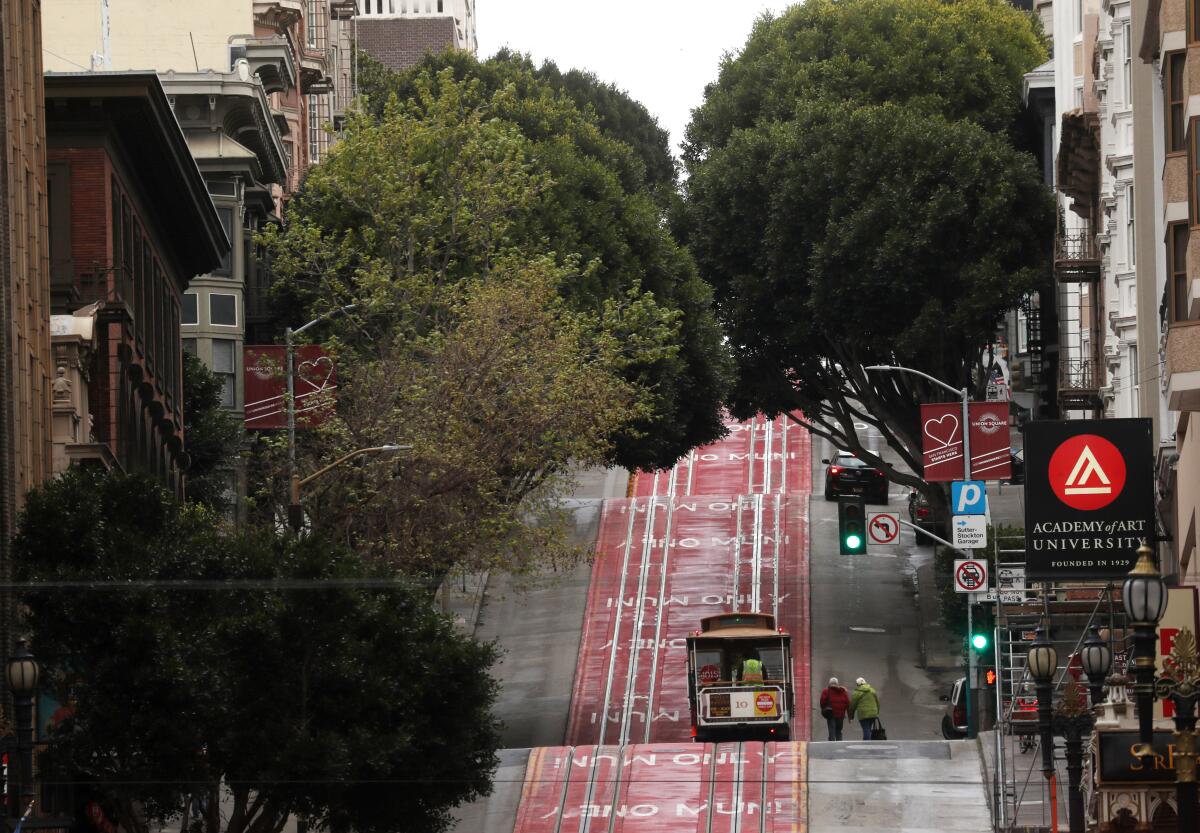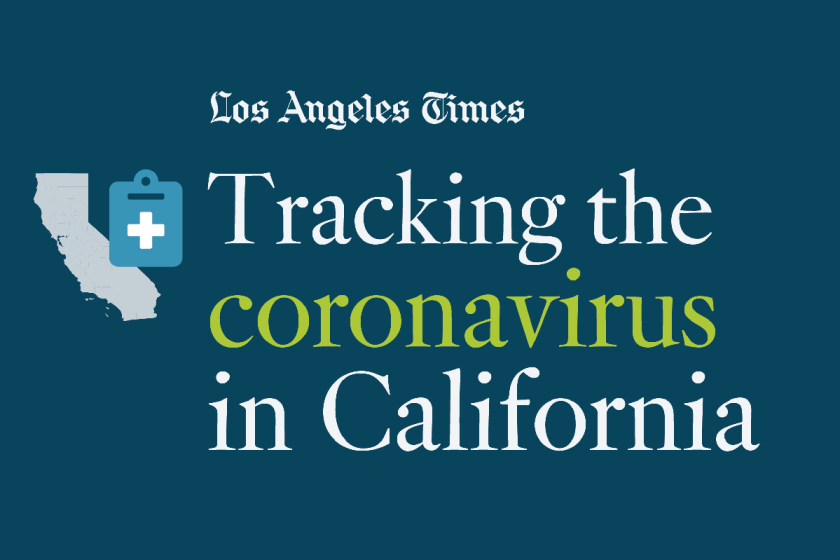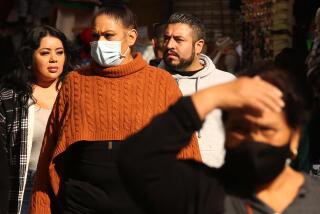As coronavirus spreads, 7 Bay Area counties ordered to shelter in place

Seven counties in the greater San Francisco Bay Area issued sweeping orders Monday that will force most businesses to close and residents to “shelter-in-place” inside their homes — the nation’s most stringent public health measures yet as state and local governments strain to rein in the coronavirus.
San Francisco Mayor London Breed called Monday’s order a necessity, suggesting that the federal response to the COVID-19 virus had been too slow and that local governments needed to take bold action to slow the sometimes deadly virus.
While it is possible Southern California authorities will issue similar orders, for now, the focus is on the Bay Area, home to the greatest number of cases with counties reporting three deaths in just the last two days.
“Many are calling this the new normal,” Breed said at an afternoon news conference, referring to the restrictions. “Well, it’s the new normal, temporarily, in an effort to protect public health.”
“These measures will be disruptive to day-to-day life,” she added. “But there is no need to panic.”
The order was issued by public health officials in San Francisco and six other counties — Santa Clara, San Mateo, Marin, Contra Costa, Alameda and Santa Cruz, and also from the city of Berkeley. The actions affect nearly 7 million residents and thousands of businesses. It was scheduled to take effect at midnight Monday and to remain in force for three weeks, until April 7.
Stay at home as much as possible, officials say, but there are exceptions, like to go out and get food, pick up medicine, buy gas, go to the bank and check up on relatives.
Public health experts praised the region’s action, while residents, business owners and workers were divided. Some welcomed the restrictions as necessary for the common good, while others feared they could threaten jobs and livelihoods, doing more harm than the virus itself.
The measures are designed to prevent COVID-19 from spreading so quickly that hospitals get overrun with a surge of patients. Dr. George Rutherford, a public health epidemiologist at UCSF, said the rules should significantly slow the spread of the virus in the coming weeks.
“It’s going to change it,” Rutherford said, “and it’s going to change it for the better.”
The social-distancing directives stemmed from a part of California facing possibly the worst risk of having its health systems overwhelmed by the coronavirus, which as of Monday afternoon, had killed more than 7,000 people worldwide. In the greater Bay Area, more than 290 cases have been reported in the seven counties, with more than 130 alone in Santa Clara County, home to Stanford University and Silicon Valley. Of the 11 deaths reported in California, five have been in the Bay Area.
Orders in each of the seven counties were similarly worded — requiring all but essential businesses to shut down, but offering a fairly broad definition of what is “essential.” Police and fire departments, hospitals, grocery stores, gas stations, banks and pharmacies all will be allowed to remain in operation.
Restaurants were ordered closed to eat-in customers, but will be allowed to remain open for take-out and delivery orders. Also deemed essential and exempt from closure: the media and workers who maintain water, sewer, gas, transportation, electrical and other public systems, including the internet.
Other exemptions were allowed for laundromats, dry cleaners, hardware stores, plumbers, electricians, exterminators, and others deemed to “provide services that are necessary to maintaining the safety, sanitation, and essential operation” of homes and businesses.
If doctors and nurses don’t have masks, all the toilet paper and pasta in the world won’t save you.
Officials emphasized that, while residents should take the orders seriously, they would not be inflexible.
San Francisco Police Chief Bill Scott said police are asking the public to voluntarily comply. While violation of the health order could be enforceable as a misdemeanor, “that is an absolute last resort,” Scott said. “This is not about a criminal justice approach to a public health issue.”
The orders recognized that homeless people would not be able to shelter-in-place and instead urged them “to find shelter” adding that “government agencies are urged to take steps needed to provide shelter for those individuals.”
Health officials assured residents they also would be free to go out to buy food and medicine and other essentials. The orders also allowed for outdoor activities such as “walking, hiking or running,” while reminding residents to comply with “social-distancing” requirements set forth by health officials — to remain six feet away from others.
“You will still be able to walk your dog, or go on a hike alone or someone you live with, or even with another person, as long as you keep six feet between you,” said Dr. Grant Colfax, San Francisco director of health. He also emphasized that restaurants would be open for to-go business and that residents would be allowed to care for relatives.
“Together we will get through this,” Colfax said.
The action came after health officers from six of the seven counties conferred over the weekend and “agreed that this step is needed immediately, “ Colfax said. “Now is the time to do everything we can to prevent the situation from getting much worse in a matter of days or weeks.... Every hour counts.”
Other California counties gave no indication they would follow the Bay Area’s lead. Barbara Ferrer, Los Angeles County director of public health, said earlier on Monday that the state’s most populous county did not have the same infection rate as the Bay Area and she had no plans for a shelter-in-place order.
But she cautioned: “Nothing’s off the table for anyone, anywhere in the United States.”
For businesses and workers in Northern California, there was no question that the new order would further escalate the economic distress caused by COVID-19, this time hitting the nation’s tech capital and a region that is home to both immense wealth and stubborn poverty.
The latest maps and charts on the spread of COVID-19 in California.
Jordan Kutzer, a consultant who advises Silicon Valley startups, said he had received numerous contacts from businesses looking for funding to weather the next six to 12 months. He described a feeling of helplessness among people used to solving problems.
“There are lots of questions about what life is going to be like going forward,” said Kutzer. “And this is an area built by problem solvers. ... The people who look at big solutions all the time are looking around and saying, ‘What are we going to do?’ ”
At the lower-end of the economic ladder, workers expressed fear. Ducky’s Car Wash in Menlo Park was preparing to close Monday, putting 50 employees out of work.
“The rent still needs to get paid. But I won’t have it,” said Daniel Flores, one of the workers. He’s thinking about looking for other work, but knows that’s not going to be easy — as everything is going to shut down. He said everyone at the car wash is worried.
“A lot of these guys work two jobs. They have to to make ends meet,” Flores said. “They’re going from barely making it to nothing. It’s really scary.”
Along Menlo Park’s main shopping drag, Santa Cruz Avenue, not all businesses were ready to concede they were nonessential.
Jenny Smetana, a manager at Cheeky Monkey toy store, said she had no plans to close the following day.
“We’re going to do what we do,” she said. “Until we hear otherwise, or get an official statement, we’ll keep doing what we do.”
At the flooring store up the street, John Christiansen, manager of Abbey Carpet, said doors would be open the following morning. He said: “There are only three people working here.”
Across the Bay Area, the public health orders provoked spirited debate.
“I am surprised because I feel like I am staying six feet away from people and hand sanitizing, and it just seems a little extreme at this point,” said Dr. Nicola Longmuir, 66, a largely retired addiction physician who lives in Contra Costa County and works part time.
“But it definitely makes my life easier because I was going to draft an email to my work saying, ‘I am not coming in.’ Now I can honestly say I can’t come in.”
Edward Collins, 71, a retired police officer who lives in Pacheco, called the orders “a tempest in a teapot.”
“I don’t know how we can stop the virus anyway, how we can slow it down,” he said. “To me this is just a big inconvenience over something that is not much more than a cold.”
Katherine Trent, 28, a Lafayette resident who does public relations for a dentist, welcomed the action.
“Personally I think I would have been more comfortable if it had happened sooner,” she said. “I think we are a little bit behind. I know it’s going to be tough for everyone to stay at home, but it is necessary.”
Scott Santos, 56, an insurance broker in the upscale East Bay community of Walnut Creek, praised the shelter-in-place advisory as a wise preventive measure that might have collateral benefits.
“I see a lot of panic in people’s eyes, but I also see lot of cooperation,” Santos said, “and people willing to help each other. On Nextdoor, the social networking service, “I saw a lot of people stepping up and offering to do store runs for elderly people and people looking out for each other.”
“So I think it’s just what our country needs,” he added. “I don’t mean that we need to be sick. But our country needs something like this to come together and heal. It will help us heal.”
Times staff writers Anita Chabria, Maura Dolan and Mark Z. Barabak contributed to this report. Lin reported from Millbrae, Rust from Menlo Park and Rainey from Pasadena.
More to Read
Sign up for Essential California
The most important California stories and recommendations in your inbox every morning.
You may occasionally receive promotional content from the Los Angeles Times.















